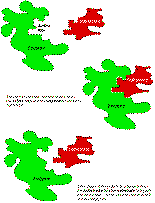 In
the same way, the FUNCTION of a protein usually depends
upon its SHAPE. This is because a protein,
just like a tool, must also have the proper "fit" in order to work. In
the same way, the FUNCTION of a protein usually depends
upon its SHAPE. This is because a protein,
just like a tool, must also have the proper "fit" in order to work.
An enzyme, for example catalyzes a chemical reaction ....... in order
to do this, the chemical (the substrate)
must fit into the active site
of the enzyme. When this does happen, the reaction proceeds rapidly
(the reaction is catalyzed).
Also ........ just like a tool ....... if
we change the shape of the protein, its function is destroyed, because
the substrate no longer "fits" in. CLICK
ON THE IMAGE TO SEE IT FULL SIZE.
NOTE:
When the shape of a protein is changed ............. then it can't perform
its function ............. if the function is not performed, the
result is often an aberrant phenotype ......... we call it
a genetic disease!
Examples are:
Phenylketonuria (PKU), Tay Sachs Disease, Sickle Cell Anemia, Cystic Fibrosis,
and Huntington's Disease. |
